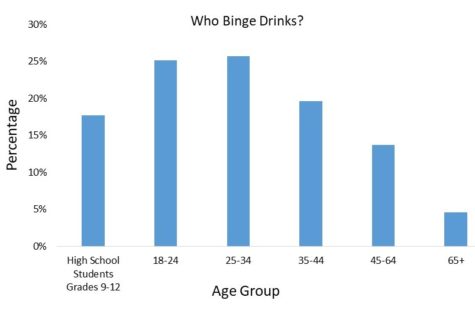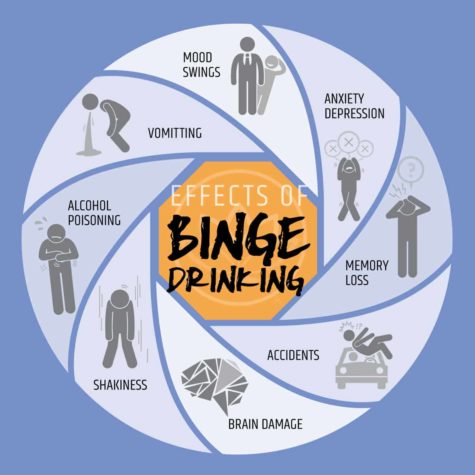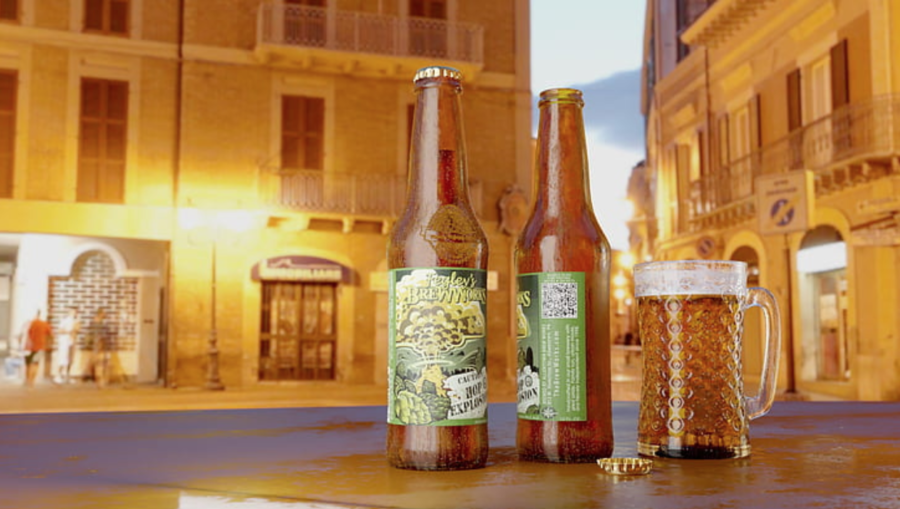The teen who had a glass of wine at dinner…
November 7, 2019
Late on a summer night after Katy and Paul Smith allowed their sixteen year old daughter to go to a party in Long Island, New York, what happened next is every parent’s living nightmare: an unexpected call from the emergency room that their child had alcohol poisoning from binge drinking at a party.
Thankfully for the Smith family, their daughter received the correct medical attention before the situation got out of hand, but the U.S still faces 2,200 deaths a year caused by alcohol poisoning – a much larger number compared to most places.
The U.S not only has a high rate of binge drinkers, but also has the highest drinking age in the world, and unlike countries such as Italy and France where drinking ages are moderately low, teenagers are raised to appreciate alcohol as part of their culture, which allows them to develop a sense of responsibility when it comes to drinking.
Diving deeper into the influences that cultural stigmas have on alcohol, one will notice how it impacts a person’s rate of consumption.
American’s tend to have a generalized stigma that alcohol is a “dangerous substance” and drinking it before the age of twenty-one is a major taboo. Unfortunately, these views on alcohol backlash. Rather than teenagers being taught responsibility when it comes to drinking, they grow up being told to never drink. This causes teenagers to go overboard at the first chance they get to drink without parental supervision and can result in a dangerous situation.
An anonymous senior shared that “People want things they can’t have and if you have it with dinner it’s normalized and it’s not something your craving whereas if your restricted you obviously want to do that and it’s rebellious and its in a kids nature and alcoholism starts in your teens and if you teach it at home this issue wouldn’t be such an issue.”
In America, drinking is demonized, which only makes teenagers want to drink even more, but the issue is they have no control over how much they drink.
Layla Bryndzia from Orlando, Florida, stated in an article that “By the time we reach that age, we don’t know how to control ourselves because our families never leveled with us and taught us how to drink in moderation.” In fact, the culture associated with drinking at parties is to see who can drink the most in the shortest period of time which creates bad habits of binge drinking.
Second year college student Stella Westlake also agreed, “because the American drinking age is 21, it creates a stigma for young people that leads to a necessary binge drinking because teens want to get as much alcohol as possible because they don’t know when the next opportunity is.”
According to the National Institute on Alcohol Abuse and Alcoholism binge drinking is defined as “5 or more drinks on a single occasion for men or 4 or more drinks on a single occasion for women, generally within about 2 hours.” For adolescents, this pattern of drinking is glorified and seen as more of a sport than a danger.

Westlake reported, “I’ve seen plenty of binge drinking in college. My second night ever freshman year my roommate told me we were going to a party and I ended up drinking a lot. I then lost my friends and was completely lost trying to find my way back to my dorm.”
Westlake’s quote is reminiscent of the fact that binge drinking has become a very large part of not only college culture, but the American culture as a whole.
This brings me to talk about the European culture, more specifically French and Italian cultures, and how they view alcohol.
In France the drinking age is only sixteen, which most likely sounds too young to most American parents, but in fact such a low drinking age is beneficial.
For the French and Italians, alcohol is a large part of their culture, unlike the American culture of binge drinking. These European countries view alcohol as part of their heritage and grow up to learn to appreciate it rather than abuse it.
“…Italy for example, children are eased into the drinking culture. It is normal for children and their parents to have a glass of wine with dinner. They are taught at an early age that alcohol is something to drink casually and in moderation, not to get drunk.”
French mother Nathalie Agussol shared that “growing up binge drinking was frowned upon and considered an embarrassment to those who got drunk. Having a small glass of wine at dinner was perfectly ok from the age of 14. It didn’t make it taboo or something that made you feel grown up because you had it.”
When a child is raised viewing alcohol as something to be drank as only for celebration and not to get drunk, they are less likely to engage in binge drinking. This is because to them, that is not how they’ve seen alcohol being used at home or in their culture. This plays a major role in binge drinking rates in Europe compared to those in America.
BMC public health conducted a study in which they looked at binge drinking patterns amongst French college students and concluded that “the amount of binge drinking by students on college campuses in France is reported to be considerably lower than in the United States.”
The main reason for this is because French students are taught responsibility when it comes to drinking at very young ages and do not grow up with the desperation to try their first drink that most Americans students have.
Anonymous American-French high-school senior stated, “It’s very implemented into the French culture at such a young age and it’s pretty normalized there which hasn’t made me as prone to drink heavily in America and it makes me not want to use alcohol out of rebellion because I’m used to drinking it at dinner.”
Cultural drinking rather than binge drinking is a much safer way to consume alcohol for a few main reasons.
First of all, when a drink is handed to a teenager at dinner, they are able to learn their limits in a safe environment versus with no parental supervision. This makes drinking much safer because their drinking with their family in a controlled setting.
“If children see adults appreciating wine – smelling, tasting, discussing and consuming it with meals and in moderation – it may bode well for their drinking habits in college”
Not only is cultural drinking more controlled, but teenagers are less likely to have desires to be sneaky when it comes to drinking. American’s views that drinking is nothing but a sin causes teenagers to want to drink even more at excessive rates.
“Their goal for drinking alcohol is to get drunk. Sometimes they end up blacking out or worse. Nevertheless, they continue to do it.”
Teenagers who are restricted from drinking at an early age are not taught what drinking in moderation is and instead go into drinking with the mindset that the person who can drink the most is the coolest.
“Girls who could handle their alcohol are seen as a lot cooler and a lot more interesting than girls who can’t.”
An anonymous senior had something to say about the American drinking culture: “Everyone knows it’s part of something in high-school and its ‘weird’ if you don’t and in college the term freshman 15 is about drinking so much alcohol that you gain weight and that’s it becomes a right of way for kids to drink and people have to specify why they don’t drink because it’s not normal not to drink.”
Drinking in college and high-school is not about the social aspect of it, but rather the physical feelings associated with being drunk.
Margot Petrie, a French-American senior at ICE high-school, was raised with having a glass of wine at dinner from a very young age: “I never feel the need to binge drink. That’s weird to me and when I see it happening within American teenagers it confuses me because I was taught to appreciate my wine and not to abuse it to get drunk.”
“Rather than discussing the flavors that are in a good liquor, the culture surrounding America, particularly underaged adolescents is to drink until sick at college parties.”
In Italy, Senator Dario Stefàno proposed a bill last month that would require schools in Italy to teach one hour of wine culture a week to students starting at age 6. This would allow students to learn the culture of wine in Italy rather than to get drunk.
Teaching kids how to properly and safely consume alcohol has much larger effects on a society than most people realize. “Cultures in which drinking is an integral part of the normal working day, and alcohol may be used to mark the transition to work (e.g. France, Spain, Peru), tend to have lower levels of alcohol-related problems.”
By allowing kids to learn the true value of wine at a young age reduces the risks of alcoholism later in life.
Another major issue with the American drinking culture is the fact that because it is so heavily frowned upon if there was ever a case of an emergency, that child is most likely to be afraid to contact a parent for help.
“When a teenager gets drunk at a party, for example, a child who is terrified of his parents’ reactions may end up drinking and driving instead of calling them for help.”
Having such a negative stigma on drinking creates fear amongst teenagers that they will receive judgement from their parents. This is dangerous because many times teenagers at parties die from alcohol poisoning because their friends were too afraid to ask for their parents’ or of a police officers help.
Americans are not the only ones who participate in these terrible drinking habits. The English and Irish are both very notorious for their excessive drinking habits as well.
In the United Kingdom and Ireland, binge drinking rates are amongst some of the highest in the world.
A survey conducted in the United Kingdom showed that forty-four percent of fifteen year old girls in the UK had been drunk on at least two occasions.
This is simply because just like the American drinking culture kids are not taught to savor their wine, but rather only see adults drink excessive amounts of it to get drunk.
English-Australian father Paul Westlake said, “English culture has a heavy history of drinking to excess. I saw so many people who were obliterated on booze at parties and on the streets where I grew up. My dad was a very heavy drinker and I saw a lot of that.”
It is very common for the English to go to a pub almost every week and get pints of beer and guzzle them down. It almost becomes a competition of who can drink the most beer.
English mother Anouk Emond had a very strong point of view regarding the English and drinking: “In England heavy drinking was the worst for getting drunk because at the time I lived there pubs closed at 11 and so everyone would go out and get as drunk as they could before they closed. “
Celebration and alcohol are heavily tied into each other but are tied into each other very differently among certain cultures.
“In societies in which alcohol is a morally neutral element of normal life (such as Italy, Spain and France), alcohol is strongly associated with celebration, but celebration is not invoked as a justification for every drinking occasion.”
Agussol said, “New Years Eve champagne flows quite freely because that’s the alcohol of choice for celebration and you don’t binge drink on champagne.”
In France, champagne is associated with a celebration and is most commonly used at birthdays or weddings, but is not abused.
However, celebration is the United States and the United Kingdom is unfortunately used as an excuse to drink rather than to really ‘celebrate’.
“Societies with an ambivalent, morally charged relationship with alcohol (such as the UK, US, Scandinavia, Australia), ‘celebration’ is used as an excuse for drinking.”
In fact because consuming large amounts of alcohol is such a common thing for most English and Americans, it’s usually not considered a form of celebration.
Paul Westlake said that “Heavy drinking was not reserved for any special occasion but was rather continuous. Every Friday and Saturday night. Nobody drank more on New Years everyone was already drinking that much.”
Emond also agreed that “In England on the occasion where you get with anyone drinking it involved. New Years and St Patrick’s day. After work or birthdays. All events become a drinking fest.”
These habits become seriously unhealthy because alcohol is ok but only as long as it is consumed in small amounts. Binge drinking, however, is extremely damaging to the body.
“Binge drinking can bring the blood alcohol level dangerously high, 0.08 (the legal limit in most of the United States) or above. Binge drinking also contributes to bad decision making and high risk behavior such as drinking and driving.”
These bad decisions when a person gets drunk puts not only themselves but others around them in serious danger because your frontal lobes, which are responsible for decision-making, are under the influence, and this can lead to many unwanted events.
When comparing between how the European’s drink to how Americans drink, the differences are quite enormous. The biggest being binge drinking versus drinking in moderation.
In the U.S there is a huge stigma around drinking before the age of twenty-one, which demonizes alcohol entirely. Teenagers, who have natural instincts to be rebellious, form terrible drinking habits of drinking as much as they can in one sitting because they don’t know when they might have another opportunity to do so.

American and the United Kingdom have some of the highest rates of alcoholism in the world. By consuming such a large amount of alcohol in such a short period of time is extremely dangerous and unhealthy for the body.
The way the French and Italians drink is a much safer approach to drinking because there is no desire to get drunk but rather to appreciate the flavors and smells of what their drinking.
If the Americans and English were to change their views on alcohol and make it a more casual thing in their day-to-day lives, just like the French and Italians, drinking would become much safer among the teenage and young-adult communities.
Even though students are taught about the dangers of binge drinking they still do it. The most effective way to prevent binge drinking amongst teenagers would be to incorporate it into their daily lives and allow them to experiment with it in a safe setting rather then making it something forbidden.
Going back to Mr. and Mrs. Smith and their sixteen year old daughter who over drank at a party, if she was taught from a young age to drink in moderation they most likely would not have received that dreadful phone call from the emergency room at two in the morning.


